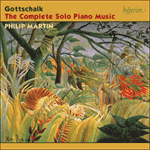
Welcome to Hyperion Records, a British classical label devoted to presenting high-quality recordings of music of all styles and from all periods from the twelfth century to the twenty-first.
Hyperion offers both CDs, and downloads in a number of formats. The site is also available in several languages.
Please use the dropdown buttons to set your preferred options, or use the checkbox to accept the defaults.

Tombe, tombe, feuille éphémère!
Voile aux yeux ce triste chemin,
Cache au désespoir de ma mère
La place où je serai demain …
It is a beautifully-wrought example of cultivated piano writing that could have come straight from the salons of mid-nineteenth-century Paris. After an unexpected outburst in the middle of the work, the central theme returns decorated with languorous demisemiquavers delicately evoking the falling leaves. This is among Gottschalk’s finest works.
from notes by Jeremy Nicholas © 1997
Tombe, tombe, feuille éphémère!
Voile aux yeux ce triste chemin,
Cache au désespoir de ma mère
La place où je serai demain …
Ce magnifique exemple d’écriture pianistique distinguée pourrait être tout droit sorti des salons parisiens du milieu du XIXe siècle. Après une explosion inattendue au cœur de l’œuvre, le thème central revient orné de triples croches langoureuses, délicatement évocatrices des feuilles tombantes. Cette œuvre compte parmi les plus belles de Gottschalk.
extrait des notes rédigées par Jeremy Nicholas © 1997
Français: Hypérion
Tombe, tombe, feuille éphémère!
Voile aux yeux ce triste chemin,
Cache au désespoir de ma mère
La place où je serai demain …
Dieses Stück ist ein herrlich gearbeitetes Beispiel kultivierter Klaviermusik, das durchaus aus den Pariser Salons Mitte des 19. Jahrhunderts stammen könnte. Nach einem unerwarteten musikalischen Sturm im mittleren Teil des Werkes kehrt das Hauptthema zurück, mit gleitenden Zweiunddreißigstelnoten, die auf gefühlvolle Weise das Bild fallender Blätter heraufbeschwören. Hier präsentiert sich uns eines von Gottschalks hervorragendsten Werken.
aus dem Begleittext von Jeremy Nicholas © 1997
Deutsch: Manuela Hübner
 Gottschalk: The Complete Solo Piano Music Gottschalk: The Complete Solo Piano MusicWith his idiomatic and graceful style, pianist Philip Martin has established himself as the foremost exponent of Gottschalk. The composer had a unique spontaneity and individuality which Martin’s performances bring vividly to the fore. The complet ...» More |

